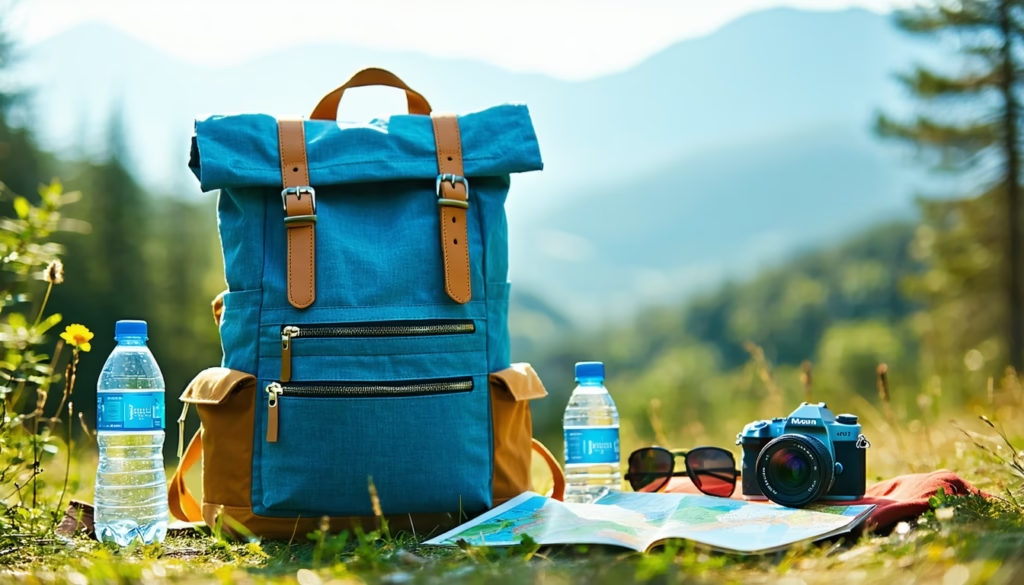Lightweight Yet Durable Fabrics Ideal For Compact Weekender Bags

When we’re hunting for the perfect lightweight weekender backpack, fabric choice can make or break our trip. Ever thought about how some weekenders hold up to daily wear yet barely add any heft? That blend of featherlight feel and rugged toughness comes down to the textile under the hood. In this guide, we’ll walk you through weight versus strength, compare go-to materials, explore advanced options, and share our best care and packing tips.
In this guide, we’ll cover:
- How to balance fabric weight and durability
- Pros and cons of common textiles
- Next-gen ultralight fabrics like Dyneema
- Sustainable picks and easy-care routines
Choosing The Right Fabric
Picking the best material starts with understanding trade-offs. Some fabrics boast low weight while others win on abrasion resistance. Let’s break down the core factors.
Assessing Weight And Strength
Fabric weight typically gets measured in grams per square meter (gsm) or denier (D). Lower-denier textiles—think 70D nylon at roughly 50 gsm—feel ultra light but can snag if you overload them. Heavier options like 500D Cordura hit around 260 gsm, which offers superior tear resistance at the cost of extra bulk.
When we track load-out numbers on our weekender backpack weight guide, we see that shaving even 100 grams from the fabric can mean fewer shoulder aches. Aim for a balance—enough sturdiness to face zippers, handles, and the occasional airport slide without lugging around dead weight.
Considering Water Resistance
A fabric’s water resistance often comes from a durable water repellent (DWR) coating or an inner laminate. Nylon and polyester can both get DWR treatments that help beads of water roll off the surface. For fully sealed seams and a watertight exterior, look for backpacks made with coated fabrics or bonded laminates.
If you’re eyeing a waterproof weekender backpack, check whether the fabric uses polyurethane (PU) or thermoplastic polyurethane (TPU) coating. TPU holds up better under abrasion, while PU tends to be lighter but may degrade faster in harsh sun.
Balancing Cost And Maintenance
Higher-end textiles command premium prices. You’ll often pay more per yard for advanced fabrics like Dyneema composite or reinforced Cordura. Budget-friendly picks such as basic polyester or canvas variants cost less but might need patches sooner.
Cleaning also varies—synthetic fabrics usually wipe or machine-wash clean, whereas canvas can require hand scrubbing and prolonged drying. We found easy-care fabrics save time when you’re on the road. For step-by-step tips, see our cleaning weekender backpack guide.
Comparing Popular Materials
We’ve narrowed down the workhorses you’ll find in most compact weekenders. Here’s how each material stacks up.
Nylon Variants
You’ll spot nylon in countless travel packs. It nails the balance between weight and durability.
210D Ripstop Nylon
210D ripstop weighs about 85 gsm and shows a grid pattern woven into the yarns. That grid stops small tears from ballooning into big rips.
Pros
- Light and packable
- Good abrasion resistance
- Holds water-repellent coatings well
Cons
- Less tear-proof than heavier nylons
- Coating may wear off over time
500D Cordura Nylon
Cordura’s a heavyweight contender at roughly 260 gsm. It’s the go-to for military gear and work packs.
Pros
- Exceptional tear and abrasion resistance
- Maintains shape under load
- Long lifespan
Cons
- Noticeably heavier
- Bulkier when folded
Want a deep dive on nylon pack styles? Check out our roundup of the nylon weekender backpack picks.
Polyester Options
Polyester often costs less than nylon and resists UV fading better.
300D Polyester
About 110 gsm, this mid-weight fabric works well for casual weekend packs. It’s less prone to stretching when wet.
- Affordable and widely available
- Quick-drying finish
- Lower abrasion resistance than nylon
Recycled Polyester
Made from post-consumer plastics, recycled polyester offers an eco edge. Performance mirrors virgin polyester, though cost goes up.
- Reduces landfill plastic
- Similar durability to standard polyester
- Often treated with eco-friendly finishes
If sustainability tops your list, explore our eco-friendly weekender backpack guide.
Natural Fabrics
Cotton-based textiles bring character and can soften over time.
Canvas Variants
Traditional cotton canvas clocks in at 12–16 oz per square yard (400–550 gsm), so expect extra heft. It’s tough, ages with a patina, and often gets waxed for water resistance.
- Classic style and feel
- High abrasion resistance
- Heavier and bulkier
Dive deeper in our canvas weekender backpack review.
Waxed Canvas
Waxed treatments boost water repellency, creating an almost weather-resistant shell. You’ll see slight wax marks, which develop character after use.
- Improved water resistance
- Unique vintage look
- Requires re-waxing every year or two
Exploring Advanced Textiles
For minimalists chasing every last gram, these modern innovations deserve a look.
Dyneema Composite Fabrics
Also known as DCF or Cuben Fiber, Dyneema laminates weigh as little as 30 gsm and boast outstanding tear strength. They repel water, resist abrasion, and pack down super small. The catch? Price tags can double traditional nylon.
X Pac Laminates
Built from polyester scrim and waterproof film, X-Pac fabrics offer one-way moisture release and crisp structure. They sit around 120–150 gsm—heavier than pure DCF but lighter than Cordura. Perfect if you want shape-holding panels in a pack.
TPU Coated Materials
Thermoplastic polyurethane coatings bond directly to a woven base, creating a waterproof but flexible shell. You’ll see TPU in roll-top packs and dry-bag hybrids. At roughly 100–200 gsm, these fabrics strike a balance between protection and weight.
Ever wondered how those ultralight fabrics withstand a rough airline conveyor belt? Advanced laminates and coatings are the secret.
Prioritizing Sustainable Options
More travelers opt for eco-conscious picks. Here’s what to look for.
Recycled Material Benefits
Recycled nylon or polyester slashes virgin resin use and keeps plastic waste out of oceans. Performance matches standard synthetics, though recycled options can cost 10–20 percent more per yard. For a greener choice, check brands that offer take-back or repair programs.
Organic Cotton Canvas
Grown without synthetic pesticides, organic canvas brings the tactile feel of traditional cotton with a smaller eco footprint. Expect a bit more weight—typically 450–600 gsm—but appreciate the biodegradability when you retire your bag.
Caring For Your Fabric
A little maintenance goes a long way toward extending your pack’s life.
Cleaning And Maintenance
- Spot clean stains with a mild soap solution
- Machine wash synthetics on a gentle cycle, then air-dry
- Apply DWR spray every few months to boost water resistance
For detailed steps, visit our cleaning weekender backpack tutorial.
Repair And Patching
Got a snag or tear? Keep a patch kit or fabric tape in your travel pouch. Nylon and polyester self-adhesive patches stick on cold, while canvas benefits from needle-and-thread stitching plus wax re-application.
Storage And Protection
Store your pack uncompressed in a cool, dry spot. Avoid direct sun to prevent UV damage. If leather accents are involved, treat them with a leather conditioner every six months.
Optimizing Weekender Performance
A lightweight pack fabric pairs best with smart organization. Here’s how to squeeze every inch.
Using Packing Cubes
Packing cubes keep clothes compressed and easy to access. They also protect delicate fabrics from abrasive lining materials. Check out our full guide on packing cubes in backpack.
Organizing Compartments Efficiently
Use internal pockets for tech and valuables. Mesh slip pockets hold socks and chargers in place. For quick grabs, front zip compartments work best. You can compare layout styles in our weekender backpack features breakdown.
Balancing Weight Distribution
Load heavy items close to your spine and low in the pack. Snacks, shoes, and toiletry kits go at the bottom or in exterior pockets. Don’t forget to snap chest straps for extra stability—see our tips on the sternum strap backpack setup.
Frequently Asked Questions
What Makes A Fabric “Lightweight” For A Weekender Backpack?
Lightweight fabrics usually fall between 30 and 120 gsm or use low-denier yarns. They minimize bulk yet often need reinforced panels to handle stress.
Is Ripstop Nylon Durable Enough For Frequent Travel?
Yes. Ripstop weaves include thicker threads at regular intervals, which stop small tears from spreading. It’s a travel-tested option for many pack makers.
How Does Polyester Compare To Nylon In Wet Conditions?
Polyester resists UV degradation better and stretches less when wet. Nylon typically dries faster and offers higher abrasion resistance.
Are Advanced Laminates Worth The Extra Cost?
If you value every gram and plan intense back-to-back trips, laminates like Dyneema or X-Pac can pay off. For occasional travelers, mid-weight synthetics often suffice.
Can I Wash A Canvas Weekender Bag In A Machine?
We don’t recommend it. Canvas benefits from spot cleaning or hand wash. Overly vigorous cycles can strip wax coatings and shrink the fabric.
How Often Should I Reapply Water-Repellent Coating?
For DWR finishes, plan to reapply every six months or after roughly five machine washes. Performance sprays take just minutes to apply.
What’s The Best Way To Store A Pack Between Trips?
Empty all pockets, air it out thoroughly, then store uncompressed in a cool, dry place away from direct sunlight. This prevents mold and fabric breakdown.
Can I Patch Advanced Fabrics Like Dyneema Myself?
Patch options exist but can be pricey. Many brands offer repair services for laminates to ensure seams and coatings stay intact.
Key Takeaways For Weekender Fabrics
- Match fabric weight (gsm or denier) to your travel style to avoid overloading
- Nylon ripstop and Cordura balance weight and toughness for everyday use
- Polyester and recycled variants offer UV resistance and eco benefits
- Natural canvas delivers a classic look but comes with extra heft
- Advanced laminates like Dyneema and X-Pac shine for ultralight aficionados
- Regular cleaning, DWR reapplication, and proper storage extend fabric life
- Smart packing cubes and balanced loading optimize your carry experience
Ready to pick your ideal fabric for a feather-light yet durable travel companion? Share your favorite material in the comments below and help fellow travelers pack smarter.


